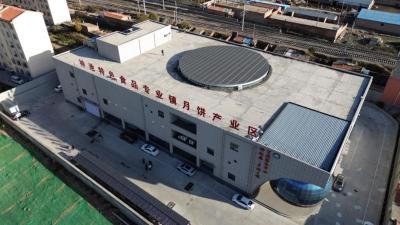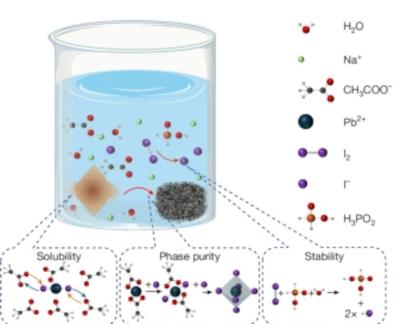Perovskite Solar
What are perovskites?
Perovskites refer to a class of materials that share a similar structure, which display a myriad of exciting properties like superconductivity, magnetoresistance and more. These easily synthesized materials are considered the future of solar cells, as their distinctive structure makes them perfect for enabling low-cost, efficient photovoltaics. They are also predicted to play a role in next-gen electric vehicle batteries, sensors, lasers and much more.
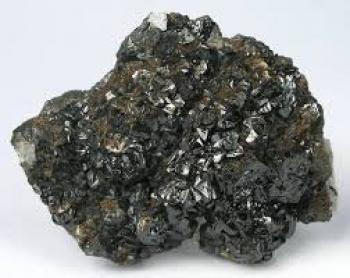
How does the PV market look today?
In general, Photovoltaic (PV) technologies can be viewed as divided into two main categories: wafer-based PV (also called 1st generation PVs) and thin-film cell PVs. Traditional crystalline silicon (c-Si) cells (both single crystalline silicon and multi-crystalline silicon) and gallium arsenide (GaAs) cells belong to the wafer-based PVs, with c-Si cells dominating the current PV market (about 90% market share) and GaAs exhibiting the highest efficiency.
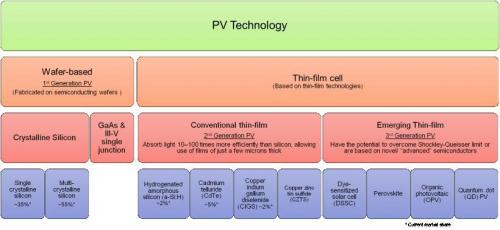
Thin-film cells normally absorb light more efficiently than silicon, allowing the use of extremely thin films. Cadmium telluride (CdTe) technology has been successfully commercialized, with more than 20% cell efficiency and 17.5% module efficiency record and such cells currently hold about 5% of the total market. Other commercial thin-film technologies include hydrogenated amorphous silicon (a-Si:H) and copper indium gallium (di)selenide (CIGS) cells, taking approximately 2% market share each today. Copper zinc tin sulphide technology has been under R&D for years and will probably require some time until actual commercialization.
What is a perovskite solar cell?
An emerging thin-film PV class is being formed, also called 3rd generation PVs, which refers to PVs using technologies that have the potential to overcome current efficiency and performance limits or are based on novel materials. This 3rd generation of PVs includes DSSC, organic photovoltaic (OPV), quantum dot (QD) PV and perovskite PV.
A perovskite solar cell is a type of solar cell which includes a perovskite structured compound, most commonly a hybrid organic-inorganic lead or tin halide-based material, as the light-harvesting active layer. Perovskite materials such as methylammonium lead halides are cheap to produce and relatively simple to manufacture. Perovskites possess intrinsic properties like broad absorption spectrum, fast charge separation, long transport distance of electrons and holes, long carrier separation lifetime, and more, that make them very promising materials for solid-state solar cells.
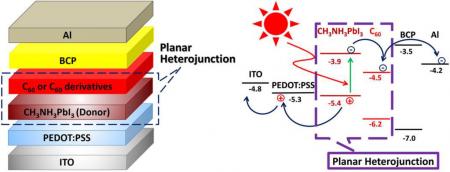
Perovskite solar cells are, without a doubt, the rising star in the field of photovoltaics. They are causing excitement within the solar power industry with their ability to absorb light across almost all visible wavelengths, exceptional power conversion efficiencies already exceeding 20% in the lab, and relative ease of fabrication. Perovskite solar cells still face several challenge, but much work is put into facing them and some companies, are already talking about commercializing them in the near future.
What are the advantages of Perovskite solar cells?
Put simply, perovskite solar cells aim to increase the efficiency and lower the cost of solar energy. Perovskite PVs indeed hold promise for high efficiencies, as well as low potential material & reduced processing costs. A big advantage perovskite PVs have over conventional solar technology is that they can react to various different wavelengths of light, which lets them convert more of the sunlight that reaches them into electricity.
Moreover, they offer flexibility, semi-transparency, tailored form factors, light-weight and more. Naturally, electronics designers and researchers are certain that such characteristics will open up many more applications for solar cells.
What is holding perovskite PVs back?
Despite its great potential, perovskite solar cell technology is still in the early stages of commercialization compared with other mature solar technologies as there are a number of concerns remaining.
One problem is their overall cost (for several reasons, mainly since currently the most common electrode material in perovskite solar cells is gold), and another is that cheaper perovskite solar cells have a short lifespan. Perovskite PVs also deteriorate rapidly in the presence of moisture and the decay products attack metal electrodes. Heavy encapsulation to protect perovskite can add to the cell cost and weight. Scaling up is another issue - reported high efficiency ratings have been achieved using small cells, which is great for lab testing, but too small to be used in an actual solar panel.
A major issue is toxicity - a substance called PbI is one of the breakdown products of perovskite. This is known to be toxic and there are concerns that it may be carcinogenic (although this is still an unproven point). Also, many perovskite cells use lead, a massive pollutant. Researchers are constantly seeking substitutions, and have already made working cells using tin instead. (with efficiency at only 6%, but improvements will surely follow).
What’s next?
While major challenges indeed exist, perovskite solar cells are still touted as the PV technology of the future, and much development work and research are put into making this a reality. Scientists and companies are working towards increasing efficiency and stability, prolonging lifetime and replacing toxic materials with safer ones. Researchers are also looking at the benefits of combining perovskites with other technologies, like silicon for example, to create what is referred to as “tandem cells”.
Researchers design new perovskite-based back contact solar cell
Researchers from the University of Sheffield, Power Roll, National Physical Laboratory and Swansea University have developed a new type of back contact (BC) solar cell design, using perovskite.
The team used a Hard X-ray nanoprobe microscope at Diamond Light Source in Oxfordshire to take detailed images of the solar cells whose traditional structure resembles a sandwich with several layers deposited in a specific order. Claiming this to be the 1st time such an analysis was carried out, the microscope helped them see hidden problems such as empty spaces, flaws and boundaries between tiny crystals within the semiconductor material.
Risen Energy reports perovskite/HJT tandem solar cells with 30.99% PCE
It was reported that China-based Risen Energy, a company primarily focused on grid-connected PV power generation systems, announced its new achievement in the research and development of perovskite and HJT tandem solar cells. A power conversion efficiency of 30.99% was reportedly achieved by Risen Energy’s R&D institution, and the result was confirmed by the China National Center of Supervision and Inspection on Solar Photovoltaic Products Quality (CPVT).
As a leading solar module manufacturer in China, Risen Energy believes that HJT solar cells with unique structure and features are promising products among p-type and n-type single junction solar cells. HJT’s advantages are significant in perovskite and silicon tandem solar cells, making it naturally suitable as a base for tandem cells. HJT is seen as one of the best bottom cells for crystalline silicon and perovskite tandem cells. Other types of crystalline silicon cells, due to the lack of ITO film, require redesign of the structure prior to tandem processing, which increases cost and complexity.
Panasonic to present an artistic prototype based on perovskite solar cells at the Osaka Kansai Expo
Panasonic has announced it will exhibit an artistic prototype based on glass-type perovskite solar cells at the Panasonic Group Pavilion "Nomo no Kuni" at the 2025 World Expo in Japan (Osaka-Kansai Expo). For this Expo, Panasonic has collaborated with Heralbony, which has worked on many projects to decorate towns with artworks drawn by artists with disabilities, to express "Kaede no Scissors" by Wajima Kaede, a contracted artist of the company.
Image credit: Panasonic
Panasonic's glass-type perovskite solar cells are characterized by their high degree of freedom in size, transparency, and drawing, achieved by combining unique material technology, inkjet coating methods, and laser processing technology. The company is currently developing the technology to commercialize the "power-generating glass". This prototype makes use of these features, broadening the scope of design expression using perovskite solar cells and demonstrating the possibility of creating a world where electricity is generated in a more natural way. This is the world's first case (according to Panasonic research as of February 14, 2025) where art has been expressed using perovskite solar cells.
Microquanta completes rooftop perovskite project
Microquanta has announced the completion of what it claims to be the world's largest building-integrated photovoltaic (BIPV) project based on perovskite solar panels. Installed on the translucent roof of the University Student Entrepreneurship Center in Shenchi County, Shanxi Province, the project has a capacity of 17.92 kWp.
Microquanta specified that its custom-designed double-glass perovskite modules measure 1,200 mm x 1,000 mm and achieve a light transmittance of around 40%, allowing daylight into the building interior while generating electricity.
Novel furan-based polymer could enable hybrid PSCs with improved efficiency and stability
Researchers from Singapore's Nanyang Technological University and France's University of Lille (CNRS) have developed a biomass-derived furan-based conjugated polymer, PBDF-DFC, enabling a simplified direct precursor integration fabrication method for hybrid perovskite solar cells (HPSCs).
Unlike traditional thiophene-based polymers, PBDF-DFC reportedly exhibits high solubility in perovskite precursor solvents, allowing direct incorporation into the precursor solution. This direct precursor integration approach could significantly streamline the fabrication process, reducing steps and potentially lowering production costs.
P3C and NISE form partnership to accelerate the market entry of perovskite-based solar technology in India
India-based P3C has announced a partnership with the National Institute of Solar Energy (NISE).
P3C and NISE have signed a Memorandum of Understanding (MoU) to accelerate India’s transition to a low-carbon, sustainable future. This partnership will focus on advancing perovskite solar technology and powering next-generation solar solutions, including glass and flexible perovskite modules, tandem solar cells, and advanced PV innovations for both urban and rural environments. The two parties' shared goal is to make clean energy accessible, efficient, and scalable across India, from rooftops and farmlands to smart cities and remote villages.
Solaires secures SDTC funding
Solaires Entreprises, a Canadian clean technology company pioneering perovskite-based photovoltaic solutions, has announced that it has received CAD$1,550,000 (around US$1,092,000) in non-dilutive funding from Sustainable Development Technology Canada (SDTC).
This funding will support the continued advancement and commercialization of Solaires’ innovative perovskite photovoltaic technology, allowing their PVModules to be brought into new applications like transportation and building-integrated solutions. These advancements will enable more sustainable solutions for low-power electronic devices and will catalyze massive GHG savings in the transportation and energy markets.
New low-cost and scalable recycling method makes perovskite solar cells more sustainable
Researchers from Linköping University, Cornell University, Westlake University and the University of Toledo have reported a low-cost, green-solvent-based holistic recycling method to restore all valuable components from perovskite solar cells (PSCs) waste.
Scheme of recycling process with a water-based solution. Three main additives (NaOAc, NaI and H3PO2) are added to address perovskite solubility, phase purity and solution stability issues in water solution. Image credit: Nature
The scalable, aqueous-based method to recycle perovskite solar cells could offer an environmentally friendly solution that minimizes end-of-life waste while maintaining performance. This addresses various sustainability concerns – such as toxicity, limited recycling options, and resource depletion – that pose significant challenges to the widespread adoption of PSCs.
Novel mixed-polymer-C60 strategy enables inverted perovskite solar cell with 25.6% efficiency
An international team, including researchers from EPFL, CNR SCITEC, Fujian Normal University, Southern University of Science and Technology (SUSTech) and others, has used an n-type polymeric additive to stabilize C60 molecules for use in inverted perovskite solar cells. The researchers reportedly designed a solar cell with the highest efficiency value ever recorded for perovskite devices based on solution processed C60 electron transport layers.
The team explained that C60 is currently the best-performing type of ETL for perovskite solar cells, although it suffers from “significant” aggregation in solution, which makes a high-cost and complex thermal evaporation method necessary for its development. To solve this issue, it utilized an n-type polymeric additive to stabilize C60 molecules for solution processing. “We introduced an n-type polymeric additive, TPDI-BTI, constructed from the strongly electron-deficient dithienylpyrazinediimide (TPDI) and the imide-functionalized bithiophene (BTI) co-unit and applied it into the C60 ETLs,” the researchers explained. “By controlling the TPDI-BTI addition, we can systematically regulate the ETLs, including film formability and morphological stability, energy levels and electron transport dynamics, intermolecular interacting behaviors and interfacial contacts, and finally, the photovoltaic performance and long-term stability of the cells.”
WattByWatt secures Canadian government funding
Perovskite solar modules developer WattByWatt has raised CAD$975,000 (around USD$682,000) financing from the Canada's federal government, which will enable the company to increase its production capacity.

WattByWatt offers its technology as a more efficient and less expensive alternative to traditional silicon-based solar cells, particularly to recharge or power batteries in electronic devices and smart card readers. The company claims its modules can function both indoors and outdoors. It can produce customized solar panels up to 400 cm². WattByWatt’s current portfolio comprises Perovton mini-PV modules to power electronic devices in the Internet of Things (IoT) for home and industry (IIoT). These can power smoke alarms, remote controls, keypads, locks, cameras, etc.
Pagination
- Page 1
- Next page






